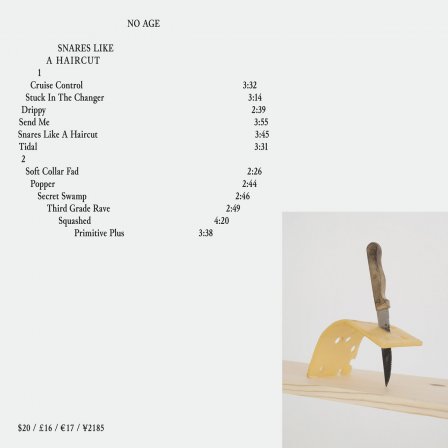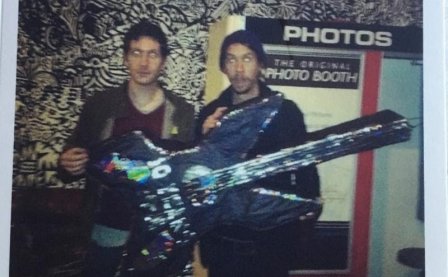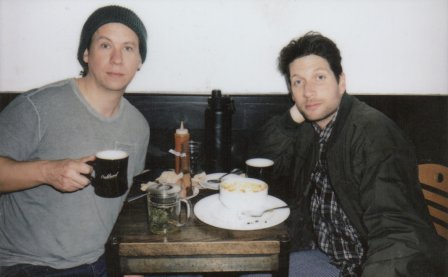Although No Age is considered “noise rock,” their music is very much in the wheelhouse of classic indie rock: caustic, unruly dissonance anchored by either pleasant oscillations between two chords or inoffensive progressions involving three or four chords (with the occasional parenthetical passages). Their ancestry can be traced back to Sonic Youth via Yo La Tengo, Dinosaur Jr., and Pavement; their siblings are Deerhunter and Japandroids. This family tree exemplifies the “outwardness” of post-post-punk rock music, the notion that great rock is meant to be heard in public, at loud shows and festivals and parties, during blaring, drunken midnight rides and unhinged makeout sessions, and maybe even in coffee shops and pizzerias. But rock is fading from the music festivals, concerts are getting to be astronomically expensive, and I wonder what people are even listening to while making out anymore. It’s not sufficient to simply claim that “rock music is communal” and should be heard in public spaces; no, this claim is rooted in how the music is constructed, heard, and experienced.
Snares Like A Haircut is a good rock album that continues No Age’s streak of making good rock albums. In preparing for this review, I dusted off Everything in Between and was surprised at how well it’s aged, transforming in just eight years from an immediate, zeitgeist-surfing force to something that, to go along with the idea of “aging,” warrants being “sipped.” The seams show on Snares Like A Haircut, maybe more so than on their earlier records, but I’m not convinced that this is a bad thing. While I always enjoy some good noise, I also like to question its necessity, whether it’s integral to a song, whether it’s inseparable from the rest of the song. In other words, is the noise part of the form and foundation of the song, or is it just “on top of” the song? Snares Like A Haircut attempts to provide a satisfying answer to this question with its meticulous manufacturing and placement of noise, resulting in one of their most thoroughly conceived albums in terms of composition, production, and mixing, which, in turn, presents a new kind of contradiction.
Overall, the production on the album is wonderful, but its subtleties don’t come through as well when it’s played loudly and on external speakers. Like many people who listen to a lot of music every day, I have a wide arsenal of ways to listen to music, all medium-to-high quality: Bluetooth earbuds, over-the-ear headphones, a Bluetooth external speaker, a record player/receiver/sound system with an aux cable, car speakers, and laptop speakers. For many albums, my mode of listening is less important, but Snares Like A Haircut is a weird, mercurial record that seems to change depending on which speakers I’m hearing it through. Listening in the car while driving or on my Bluetooth speaker while doing dishes, “Stuck in the Charger” sounds almost monolithic, full of overbearing fuzz and noise, moving parts that appear indistinguishable; however, when I listen on my headphones, I find it to be full of nuance and depth, with interesting sounds occurring simultaneously in the foreground and background, strange percussion clangs and feedback gliding in and out of the mix. In the same way, “Drippy” reveals itself via headphones to be a multi-dimensional composition built on a dazzling constellation of thoughtful use of sound and space.
Many of the tracks are like this, which isn’t a bad thing, but it’s strange that such a bombastic record seems best heard alone, isolated from the world. “Third Grade Rave” blends towering drums and breezy synths above a bed of polished guitar turbulence, its intricacies fitting together delicately like ingredients in a dish at a nice restaurant. The title track is full of typewriter clacks and shuffling lashes, far-reaching synths and layered static — it’s really an interesting and involved listen, and tenfold so on headphones. “Soft Collar Fad” is similarly constituted for intimate listening, because its rippin’ guitars become a bit muddled when allowed to mix out in the world. I get a lot of pleasure from the subtle synth tones of “Send Me,” which do come through via external speakers, but aren’t as discernible from one another. No Age’s music differs formally from that of its family tree, because their approach to space and structure is different. I can listen to Celebration Rock or Electr-O-Pura anywhere, because Japandroids and Yo La Tengo understand how their guitars and noise blend in the atmosphere — they smartly integrate the background and foreground so that their music basically sounds great wherever it’s played. This isn’t to say that No Age’s music is worse — it’s just more ornate.
Snares Like A Haircut is one of the more interesting artifacts from the “streaming age,” a time when it’s more or less acknowledged that most music will be heard alone, whether in the car, at work, doing chores, in the gym, on public transit, or otherwise. It’s a solid rock album whose dedication to artisanal noise in some ways negates its ancestry of majestic rock & roll that begs to be heard publicly; the dissonance embedded in the music of Sonic Youth and Dinosaur Jr. has become fetishized to the point where it’s a much more active condition in how we produce and listen to indie and noise music today. The funny potential consequence to this trend is that, eventually, we’re going to be living in a very quiet world, but one filled with a ton of good noise.
More about: No Age




